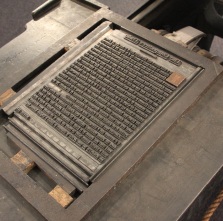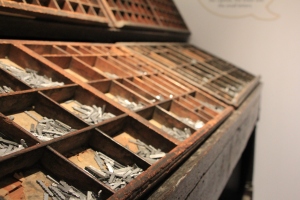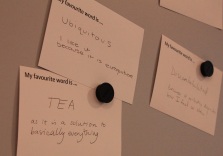As Word Stories looked at Caxton and the effect that his printing press had on English last week, I continued in a similar vein this week, by visiting the Oxford University Press Museum. It’s word nerd nirvana, the printing and publishing mother ship. There is a 19th century printing press, an original plate from Alice’s Adventures in Wonderland and dictionary entry slips handwritten by J. R. R. Tolkien.
Aside from being a worldwid e publishing giant with an extensive history, the OUP is important to us language fans because of the
e publishing giant with an extensive history, the OUP is important to us language fans because of the
monumental Oxford English Dictionary. The first ever dictionary was written by Samuel Johnson in 1755 but it was subjective and fairly informal and, as language evolves, soon out of date. When the first volume of the OED was published in 1884, it set a new standard for lexicography: it included everything from Anglo-Saxon times onwards, a thorough, detailed, historical record of English.
Of course the going wasn’t always easy. Five years into the proposed ten-year project, the first instalment was published. It covered all the words from a to ant.
James Murray, the editor at the time, refused to cut any corners and was determined to make it an entire, exhaustive study. He spent some 35 years working on the project but, sadly, died before it was completed. He had reached t.
The complete first edition was published in 1928 in ten volumes instead of the predicted four with around 400,000 words altogether. But of course, by now it had been 44 years since the first volume was published, which had become dated and needed revising. Since language is constantly changing, the dictionary needs to be continually edited.
Aside f rom the OED, some great word stories have also come from the OUP and the publishing world. The terms upper case and lower case for capitals and small letters respectively come from printing. The type is organised by letter in a large set of compartments, a case. The capital letters sit in the upper case while the small letters sit in the lower case.
rom the OED, some great word stories have also come from the OUP and the publishing world. The terms upper case and lower case for capitals and small letters respectively come from printing. The type is organised by letter in a large set of compartments, a case. The capital letters sit in the upper case while the small letters sit in the lower case.
The phrase to get the wrong end of the stick, meaning ‘to misunderstand’, comes from printing too. Printers held a stick and put the type in it, working from right to left. They had to put the letters in backwards as when they were printed, they would come out in reverse. However, if they got the wrong end of the stick, that is if they started placing the words from the left to the right, the text would come out back to front and no one would be able to understand.
While the typesetter ran out of type, or sorts, he couldn’t finish his job and had to wait until the new batch was  delivered. Until that time, he was out of sorts, which now means ‘to feel low or irritable’.
delivered. Until that time, he was out of sorts, which now means ‘to feel low or irritable’.
One last noteworthy thing that’s on display in the OUP museum is the notice board of favourite words contributed by visitors. I had a painful realisation that even though I love words, I don’t know what my favourite one is. I feel it’s akin to choosing a favourite child. All the same, I think I need one. I ended up contributing superfluous, mostly because mellifluous had already gone, but I’ve thought of hundreds of great words since (monotonous, sojourn, perturb, albeit, fuddy-duddy, zest). So I put it to you reader, what is your favourite word? Pick a good one and I might even write about it.
 also the location of her grave. It seems only right to pay homage to the queen of crime by unravelling some of the word mysteries out there.
also the location of her grave. It seems only right to pay homage to the queen of crime by unravelling some of the word mysteries out there.
 e publishing giant with an extensive history, the OUP is important to us language fans because of the
e publishing giant with an extensive history, the OUP is important to us language fans because of the


 One such word is binge. We tend to think of it as a fairly modern phenomenon, especially with regard to binge drinking. But in fact, binge was first used to mean a bout of heavy drinking in 1854. It was originally a Northern dialect word meaning ‘soak’ that became more widespread when Brits from all over the country mixed during WWI and then it began to refer to excessive eating as well as drinking.
One such word is binge. We tend to think of it as a fairly modern phenomenon, especially with regard to binge drinking. But in fact, binge was first used to mean a bout of heavy drinking in 1854. It was originally a Northern dialect word meaning ‘soak’ that became more widespread when Brits from all over the country mixed during WWI and then it began to refer to excessive eating as well as drinking.

 on Wikipedia also remarks that ‘Marc Drogin noted in his instructional manual Medieval Calligraphy: Its history and technique (1980) “for the past half-century every edition of The Oxford English Dictionary has listed an incorrect page reference for, of all things, a footnote on the earliest mention of Titivillus.”’
on Wikipedia also remarks that ‘Marc Drogin noted in his instructional manual Medieval Calligraphy: Its history and technique (1980) “for the past half-century every edition of The Oxford English Dictionary has listed an incorrect page reference for, of all things, a footnote on the earliest mention of Titivillus.”’
 When photography kicked off in the 1840s, camera obscura was clipped, to refer to the new picture-taking devices. So essentially, when you’re taking a few snapshots, you’re actually using a ‘room’.
When photography kicked off in the 1840s, camera obscura was clipped, to refer to the new picture-taking devices. So essentially, when you’re taking a few snapshots, you’re actually using a ‘room’.
 A few weeks ago, Word Stories looked at the interesting case of
A few weeks ago, Word Stories looked at the interesting case of Looking at this classic cartoon, the zzzzs say it all; Jerry’s not just relaxing or lying down, he’s asleep. We all recognise it but really, why should a line of the letter z suggest that someone is sleeping? Personally, if I were trying to represent a snoring figure, I’d use something throatier, like ghhuh or schhuuh. After all, the French use rrroo or roon and the Germans use chrr, all of which seem much closer to the actual sound. Say zzz aloud and it just doesn’t quite sound lethargic enough.
Looking at this classic cartoon, the zzzzs say it all; Jerry’s not just relaxing or lying down, he’s asleep. We all recognise it but really, why should a line of the letter z suggest that someone is sleeping? Personally, if I were trying to represent a snoring figure, I’d use something throatier, like ghhuh or schhuuh. After all, the French use rrroo or roon and the Germans use chrr, all of which seem much closer to the actual sound. Say zzz aloud and it just doesn’t quite sound lethargic enough. e letter ‘þ’ didn’t exist. Instead they had to substitute ‘y’ because they figured it looked similar enough. The became ye and also that became yt, both of which can be found in manuscripts until as late as the 18th century.
e letter ‘þ’ didn’t exist. Instead they had to substitute ‘y’ because they figured it looked similar enough. The became ye and also that became yt, both of which can be found in manuscripts until as late as the 18th century.